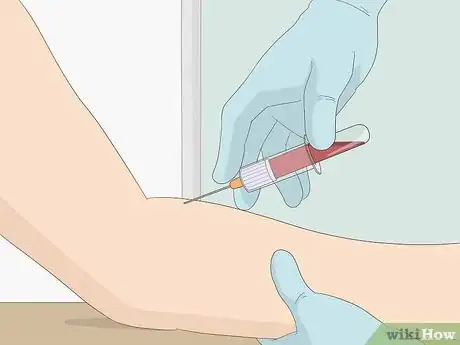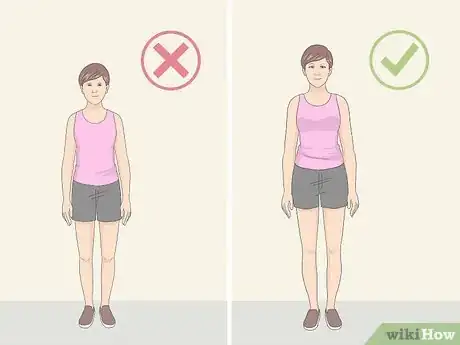This article was written by Scott Mosser, MD and by wikiHow staff writer, Megaera Lorenz, PhD. Dr. Scott Mosser is a board certified Plastic Surgeon based in San Francisco, California. Dr. Mosser is the Founder of the Gender Confirmation Center, a clinic dedicated exclusively to transgender surgeries. He received his MD from Baylor University, completed his residency in Plastic Surgery at Case Western Reserve University, and finished his fellowship in Aesthetic Surgery under Dr. John Q. Owsley, MD. He is a cofounder of the American Society of Gender Surgeons, a member of the American Society of Plastic Surgeons (ASPS), is a member of WPATH (World Professional Association of Transgender Health) and the United States Professional Association of Transgender Health (USPATH).
There are 9 references cited in this article, which can be found at the bottom of the page.
This article has been viewed 63,645 times.
Whether you’re going through an FTM/N or MTF/N transition, getting top surgery is a big decision. If you are a transgender man or non-binary transgender person considering FTM/N chest reconstruction surgery, you might want to remove your breasts or reduce their size. If you are a transgender woman considering top surgery, you might choose to undergo breast augmentation. While you may feel excited about the possibility of getting top surgery, it’s also normal to feel scared or uncertain. Before you make a decision, take the time to assess how you really feel about the idea, and work with your medical team to make sure you’re physically prepared.
Steps
Becoming Mentally and Emotionally Prepared
-
1Determine if you have persistent gender dysphoria. Gender dysphoria is a persistent feeling of distress caused by a mismatch between your gender identity and the biological sex you were assigned at birth.[1] Think about whether you feel a strong disconnect between your physical sex characteristics and what you feel to be your true gender identity, and especially whether you feel an intense desire to alter the appearance of your breasts.[2]
- For example, if you’re transitioning FTM/N, you may feel a strong desire to hide, bind, or remove your breasts.
- If you’re MTF, you might strongly wish that you had more prominent breasts and you might do things to enhance their appearance, like wearing padded bras.
- Many surgeons and insurance companies require that you have “persistent, well-documented gender dysphoria” before they will approve you for any kind of gender reassignment surgery, including top surgery. Talk to your doctor and your therapist (if you have one) about how you feel about your body and how long you’ve felt that way.
Did you know? Not all transgender people experience gender dysphoria, and the extent to which you wish to transition surgically is entirely up to you. A gender identity isn’t any less valid, even without a desire to transition physically.[3]
-
2Ask yourself how your dysphoria affects your quality of life. Living with gender dysphoria can be extraordinarily difficult. Think about whether the appearance of your chest causes you stress, anxiety, or depression. If so, you might be a good candidate for top surgery. It may be especially important to consider top surgery if other methods of managing your dysphoria, such as using a binder to flatten your chest or taking estrogen to enhance your breast size, aren’t working well for you.[4]
- Try writing up a list of specific ways that you think your quality of life could be improved by top surgery. For example, you might include things like, “My self-esteem would be improved,” or “I wouldn’t have to deal with pain from my binder anymore.”
Advertisement -
3Try to have as strong of a support network as you can. If you’re considering having any kind of major surgical procedure, it’s important to have supportive people in your life. Think about whether you have friends or family to turn to who can provide both emotional and practical support while you’re preparing for and recovering from your top surgery.[5] If so, reach out to those people and have a conversation with them about what kind of help they’re willing and able to offer.
- For example, you might ask a family member if they can come with you to the hospital to be an advocate during your surgery and recovery, or find a friend who’s willing to be a supportive listener if you’re dealing with any anxiety or stress about the procedure.
- If you don’t have any supportive friends or family, ask your doctor or therapist to recommend a support group for transgender people or people experiencing gender dysphoria.
-
4Work with a therapist to manage any mental health issues. Undergoing top surgery is a deeply personal decision. It might help to talk to a therapist and consult with your primary care doctor to discuss your physical, mental, and emotional expectations. Doing so will help you cope with any stress related to the surgery, and will also make it easier for you to make informed decisions about your health. Ask your doctor to recommend a therapist if you’re not working with one already.
- Being transgender or having gender dysphoria does not mean you are mentally ill.[6] However, transgender people often struggle with mental health conditions such as depression and anxiety due to the unique challenges they face.[7] If you’re dealing with one of these conditions, remember that you are not alone and there are treatment options available to you.
- A therapist can help you set positive, realistic goals for your transition. They can also talk to you about what to expect emotionally from the surgery and recovery process, and how to cope with any related stress.
-
5Give yourself plenty of time to establish your gender identity before surgery. Top surgery is a major procedure that will permanently change your body. Once you discover that you have gender dysphoria, you should explore your gender expression and find as comfortable of a space as possible with regards to your gender identity. This will help you make the right surgical decisions. So, before you go through with it, give yourself time to think about whether it’s something you really want to do. Even if think you’re absolutely sure right now, if you can endure the dysphoria, do your best to explore your gender identity for 12 months and see exactly how you feel at the end of that time.
- Some surgeons and insurance companies won’t approve the procedure until you’ve been living as the gender with which you identify for a full year, though this is more common for "bottom" (i.e. genitalia) surgery.
- If you’re struggling with severe gender dysphoria, waiting even a short time to make an important change like this can be very difficult. Work with your counselor, doctor, and any supportive friends and family you may have to help you cope and stay positive during that time.
-
6Ask other people who have had top surgery for advice. If you know anyone else who’s had top surgery, they can be very helpful as you try to come to a decision about your surgery.[8] If you don’t know anyone already, you may be able to meet someone you can talk to through a transgender support group in your area or an online community for trans people. Ask them questions like:
- “What do you wish someone had told you before you got your top surgery?”
- “What was your recovery like?”
- “Do you feel satisfied with how your surgery turned out?”
- “Were there any social problems or discrimination issues that you had to deal with after the surgery?”
-
7Get an assessment from your mental health provider. Before you can get insurance approval for top surgery, you’ll probably need to get a letter from your therapist affirming that they feel you are a good candidate for the procedure. If insurance approval is the route you will take, and as you consider getting a consultation with a surgeon, sit down with a therapist and go over your goals, your feelings about the surgery, and any concerns you might have about the procedure. They can help you decide whether it’s a good time for you to go ahead, and, if so, they can write a letter to your surgeon on your behalf. This letter may include:
- Information about your dysphoria, including how long you have been experiencing it
- Details about any mental health conditions you have, and how they are being treated
- A discussion of whether you understand the risks and benefits of the procedure, and how top surgery is likely to improve your quality of life
- Information about your current support system
-
8Consider external factors that might impact your surgery. Deciding when to have top surgery is a complex decision that's shaped by your feelings of dysphoria or discomfort associated with your chest. However, you may need to take other factors into account, like waiting to schedule your surgery until your fees and financing are secured. In addition, you need to be able to take time off work to facilitate your recovery, so that might impact your scheduling, as well.
- In some cases, your insurance provider may cover some or all of the costs of your procedure.
-
9Go with what feels right to you. While you can get advice and support from doctors, mental health professionals, friends, and family, it’s ultimately up to you to decide if you’re ready for top surgery. Only move ahead if you feel strongly that it’s the right decision for you.[9]
- The decision to have surgery or not is yours alone, and it’s okay for you to change your mind. Give yourself time to think, and try not to let others pressure you into doing anything you’re not comfortable with.
Meeting the Medical Requirements
-
1Consult your doctor about the risks and benefits of surgery. Before you have top surgery, sit down with your doctor or surgeon to discuss what you can expect. They can tell you about what the procedure itself will involve, what the recovery period will be like, what sorts of follow-up care you will need, and what kinds of complications are possible. They can also give you a sense of what kind of results you can realistically expect.[10]
- Top surgery is a serious procedure that has a variety of risks and potential complications. The risks of chest reconstruction surgery include bleeding, infection, scarring, and accumulation of blood or other fluids under the skin at the surgery site.[11] Breast augmentation surgery can come with similar complications, as well as asymmetry of the breasts, creases in the breasts, or leaking or displacement of the implants.[12]
- Ask your doctor to recommend a surgeon who is board-certified and experienced with the kind of top surgery you are hoping to get.
-
2Discuss different types of surgery with your doctor. During your consultation, your doctor will talk to you about which procedure is right for your unique body type and post-op goals. Each incision type and location has its own pros and cons, and there are a number of factors that will determine which procedure is the best for you, including your existing breast size, levels of firmness or elasticity, and whether you desire to maintain nipple sensitivity.
- Some of the most common incision types for top surgery include double, keyhole, and periareolar incisions.
-
3Get a physical to check your overall health. Before you have surgery, your surgeon will want to be assured that you are in good health so that the procedure will be safe for you. Allow your doctor to do a physical to check for any obvious issues.[13]
- Let your doctor know if you have any major health problems or if your family has a history of conditions such as heart disease, blood clotting disorders, or breast cancer.
- If you have any serious medical conditions, it’s important to make sure that you’re treating or managing them well before you have your surgery.
- Tell your doctor about any medications, vitamins, or supplements you’re currently taking, since this can also affect whether or not you can safely have surgery.[14]
-
4Have any required lab tests done. In addition to a physical, your doctor may also wish to do tests to rule out any health issues that might not be obvious from an exam. However, in this day and age, healthy young individuals usually do not need any blood or other tests prior to this sort of surgery. If needed, then you should consent to any required or recommended tests, such as:[15]
- Blood sugar tests
- A basic "chemistry panel"
- Complete blood count
- Tests of your liver enzymes
-
5Quit smoking if you’re a smoker. It’s extremely important for your health that you avoid smoking or using any nicotine products 3 weeks before and 6 weeks after top surgery.[16] If you’re addicted to cigarettes or other tobacco or nicotine products, talk to your doctor about the best way to quit before you schedule your surgery.
- You should also avoid alcohol and any other recreational drugs, legal or illegal, in the weeks before and after your surgery. Using drugs or alcohol can affect how you react to anesthesia and increase your chances of developing serious complications.[17]
-
6Maintain a healthy weight to reduce the risks of surgery. Being overweight or having a high BMI can make anesthesia or surgical recovery riskier. It can also affect how good the results of your top surgery look.[18] Work with your doctor or a nutritionist to set healthy and realistic goals for your weight before you have surgery.
- Eating healthy meals and getting plenty of exercise before your surgery can help ensure that you’ll have an easier recovery process.
-
7Wait until you’re old enough to make legal decisions about your care. Most surgeons recommend waiting until you’re an adult to have top surgery.[19] You’ll also need to be old enough to legally consent to surgery or have your parents/guardians supportive enough that they will consent to surgery on your behalf before you can have the procedure done. In the U.S., that typically means waiting until you’re 18.
- Some hospitals or surgeons may be willing to perform top surgery on adolescents with parental consent.
References
- ↑ https://www.nhs.uk/conditions/gender-dysphoria/
- ↑ https://www.nhs.uk/conditions/gender-dysphoria/symptoms/
- ↑ https://transequality.org/issues/resources/frequently-asked-questions-about-transgender-people
- ↑ https://www.mayoclinic.org/tests-procedures/top-surgery-for-transgender-women/about/pac-20470693
- ↑ https://www.mayoclinic.org/tests-procedures/top-surgery-for-transgender-women/about/pac-20470693
- ↑ https://www.nhs.uk/conditions/gender-dysphoria/
- ↑ https://www.psychiatry.org/patients-families/gender-dysphoria/what-is-gender-dysphoria
- ↑ https://www.mayoclinic.org/tests-procedures/top-surgery-for-transgender-men/about/pac-20469462
- ↑ https://www.amsa.org/action-committee/gender-and-sexuality/transgender-health/
- ↑ https://www.mayoclinic.org/tests-procedures/top-surgery-for-transgender-men/about/pac-20469462
- ↑ https://www.mayoclinic.org/tests-procedures/top-surgery-for-transgender-men/about/pac-20469462
- ↑ https://www.mayoclinic.org/tests-procedures/top-surgery-for-transgender-women/about/pac-20470693
- ↑ https://www.mayoclinic.org/tests-procedures/top-surgery-for-transgender-men/about/pac-20469462
- ↑ https://www.asahq.org/whensecondscount/preparing-for-surgery/prep/preparing-for-surgery-checklist/
- ↑ https://www.mayoclinic.org/tests-procedures/top-surgery-for-transgender-men/about/pac-20469462
- ↑ https://transcare.ucsf.edu/masculinizing-chest-reconstruction-top-surgery
- ↑ https://www.asahq.org/whensecondscount/preparing-for-surgery/prep/preparing-for-surgery-checklist/
- ↑ https://transcare.ucsf.edu/masculinizing-chest-reconstruction-top-surgery
- ↑ https://www.mayoclinic.org/tests-procedures/top-surgery-for-transgender-men/about/pac-20469462
- ↑ https://www.mayoclinic.org/tests-procedures/top-surgery-for-transgender-men/about/pac-20469462


















-Step-16.webp)



-Step-26.webp)
-Step-16.webp)

















































